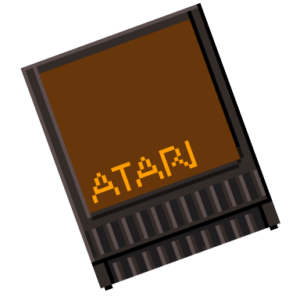Atari 400/800
The Atari 800 was announced in December 1978, though it didn’t actually start shipping until late in 1979.
Designed to look like a friendly typewriter, the Atari 800 is an expandable system with two easily accessable cartridge ports under a front cover, and a removable top with four expansion slots inside. The cartridges are very handy, just plug ’em in and go! Technologically, there’s not much to them, just some ROM chips with the program already burned into them. The Atari 800 has multiple special purpose co-processors for sound and graphics to take the load off of the 6502 CPU, and it has sprites and collision-detection built into its hardware, so it is an excellent game machine. Up to four Atari 810 floppy drives ($599.95 each) can be hooked-up, allowing fast and reliable data storage. The floppy drive uses single-sided 5 1/4-inch floppy disks, holding 90K of data on a disk. The data is transfered in serial format at 19200 baud. The Atari 820 impact dot-matrix printer ($449.95) prints 40 columns of 5×7 characters, at approximately 40 characters per second. The 810 and 820 are considered “intelligent” peripherals – they have built-in processor chips which lighten the load on the computer’s main processor. They can each be plugged directly into the Atari 400 or 800, with no other inteface required.
Unfortunately, the Atari 800 doesn’t have any standard peripheral ports for non-Atari printers, modems, etc. So in 1980, Atari released the Atari 850 Interface Module, which provides 4 separate RS-232-C serials ports and a single Centronics compatible printer port. It plugs into one of the controller jacks on the computer, which are actually both input/output, analog and digital ports. There are two versions of the 850. The black metal version is the original unit and is very uncommon. The newer version was plastic. The first Atari modem, the Atari 830 Acoustic Couple Modem. It has two cups on top to cradle the telephone handset, and it requires both the Atari 850 Interface Module and the TeleLink I ROM cartridge to operate. The second modem released was the Atari 835 Direct Connect Modem, a stand-alone unit which hooks directly to the telephone line and does not use the 850 Interface Module. It does, however, require the Atari Telelink II ROM cartridge. The 835 modem/cartridge pair features 300 baud upload/download speed, autodial, and they even remember the last two numbers dialed.
Additional accessories include the external keypad ($124.95) for fast data entry. Although an external floppy drive was available, beginners often used the cheaper but less reliable cassette tape drive. Numerous games were released on cassette tape, and Atari produced introductory and programming tapes. Like the Atari 400, the 800 was designed by a team which included Jay Miner, who later went on to help design the Amiga 1000. In 1983, Atari released the 800XL computer. It has the same CPU as the Atari 800, and runs at the same speed. Basically a cheaper version of the 800, it is supposed to be compatible with all Atari 800 software and peripherals, but it isn’t. Improvements include: 64K base RAM vs. 8K, parallel I/O port (PBI), and general purpose I/O port.
“‘Atari 8-bit’ is a collective name for a range of 8-bit computers that Atari launched and supported between 1979 and 1992. Beginning with the Atari 400 and 800, and ending with the XE range.
___
## Emul
System | Emulator | Notes
:- | – | –
Windows / Mac OS / Linux | [MAME/MESS](https://www.mamedev.org) | Setname: `a400` (Atari 400), `a800` (Atari 800), `a800xl` (Atari 800XL), `a130xe` (Atari 130XE)
Various | [Atari800](https://atari800.github.io) | –
Windows | [Altirra](http://www.virtualdub.org/altirra.html) | –
Mac OS | [Atari800MacX](https://github.com/atarimacosx/Atari800MacX) | –
Mac OS | [Rainbow](https://www.bannister.org/software/rainbow.htm) | –
Linux | [Atari++](http://www.xl-project.com) | –
Windows | [Pantheon](http://bostjan-grandovec.si/Content/News.htm) | Multi platform emulator
Retroarch | [via lr-atari800](https://docs.libretro.com/library/atari800/) | –
RetroPie | [via Atari800 and lr-atari800](https://github.com/RetroPie/RetroPie-Setup/wiki/Atari-800-and-5200) | default is lr-atari800
*Emulator information last updated 18th April 2020*
___
## Tech
**Name** | Atari 400 / 800
:- | –
**Launched** | 1979
**Codename** | Candy (Atari 400) / Colleen (Atari 800)
**Origin** | United States
**Processor** | MOS Technology 6502B
**Developed by** | Jay Miner
**Memory** | 8KB originally (the Atari 800 could be expanded by the user to 48K). Later models came with 16KB
**Display Output** | Built-in RF modulator
**Display Size** (characters) | 40 x 25
**Colours** | Palette of 256 colours
**Storage** | ROM Cartridge, Floppy Disk, Cassette
**Input** | Standard built-in Keyboard (Atari 800), Membrane keyboard (Atari 400), support for 4 joysticks
**Cost** | $550 (Atari 400, US launch), $1,000 (Atari 800 US launch)
**Name** | Atari 600XL / 800XL
:- | –
**Launched** | 1982
**Origin** | United States
**Processor** | MOS Technology 6502C
**Memory** | 16KB, max 64KB (Atari 600XL), 64KB, max 128KB (Atari 800XL)
**Colours** | Palette of 256 colours
**Storage** | ROM Cartridge, Floppy Disk, Cassette
**Input** | Built-in Keyboard, support for 2 joysticks
**Name** | Atari 65XE / Atari 130XE
:- | –
**Launched** | 1985
**Origin** | United States
**Processor** | MOS Technology 6502C
**Memory** | 64KB RAM (Atari 65XE), 128KB RAM (Atari 130XE), 24KB ROM
**Colours** | Palette of 240 colours
**Storage** | ROM Cartridge, Floppy Disk, Cassette
**Input** | Built-in Keyboard, 2 x joystick ports
___
## Reso
* [Atari Museum](http://www.atarimuseum.com/computers/8BITS/400800/ATARI800/A800.html)
* [Atari Mania](http://www.atarimania.com)”

